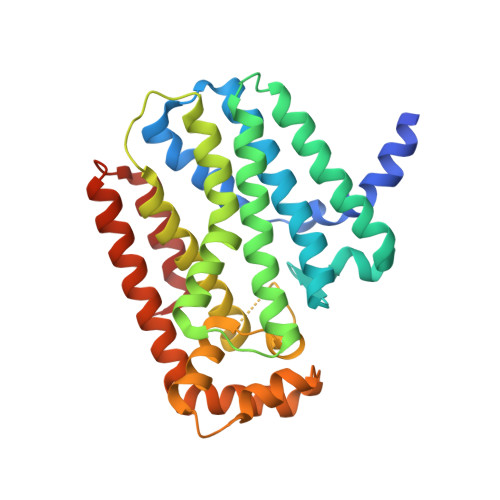Metal Coordination Is Crucial for Geranylgeranyl Diphosphate Synthase-Bisphosphonate Interactions: A Crystallographic and Computational Analysis.
Lisnyansky, M., Yariv, E., Segal, O., Marom, M., Loewenstein, A., Ben-Tal, N., Giladi, M., Haitin, Y.(2019) Mol Pharmacol 96: 580-588
- PubMed: 31427399
- DOI: https://doi.org/10.1124/mol.119.117499
- Primary Citation of Related Structures:
6R4V - PubMed Abstract:
Geranylgeranyl diphosphate synthase (GGPPS) is a central metalloenzyme in the mevalonate pathway, crucial for the prenylation of small GTPases. As small GTPases are pivotal for cellular survival, GGPPS was highlighted as a potential target for treating human diseases, including solid and hematologic malignancies and parasitic infections. Most available GGPPS inhibitors are bisphosphonates, but the clinically available compounds demonstrate poor pharmacokinetic properties. Although the design of novel bisphosphonates with improved physicochemical properties is highly desirable, the structure of wild-type human GGPPS (hGGPPS) bound to a bisphosphonate has not been resolved. Moreover, various metal-bisphosphonate-binding stoichiometries were previously reported in structures of yeast GGPPS (yGGPPS), hampering computational drug design with metal-binding pharmacophores (MBP). In this study, we report the 2.2 Å crystal structure of hGGPPS in complex with ibandronate, clearly depicting the involvement of three Mg 2+ ions in bisphosphonate-protein interactions. Using drug-binding assays and computational docking, we show that the assignment of three Mg 2+ ions to the binding site of both hGGPPS and yGGPPS greatly improves the correlation between calculated binding energies and experimentally measured affinities. This work provides a structural basis for future rational design of additional MBP-harboring drugs targeting hGGPPS. SIGNIFICANCE STATEMENT: Bisphosphonates are inhibitors of geranylgeranyl diphosphate synthase (GGPPS), a metalloenzyme crucial for cell survival. Bisphosphonate binding depends on coordination by Mg 2+ ions, but various Mg 2+ -bisphosphonate-binding stoichiometries were previously reported. In this study, we show that three Mg 2+ ions are vital for drug binding and provide a structural basis for future computational design of GGPPS inhibitors.
- Department of Physiology and Pharmacology, Sackler Faculty of Medicine (M.L., M.M., M.G., Y.H.), Department of Biochemistry and Molecular Biology, George S. Wise Faculty of Life Sciences (E.Y., N.B.-T.), and Sackler Faculty of Medicine (O.S., A.L.), Tel Aviv University, Tel Aviv, Israel; Ophthalmology Division, Tel Aviv Sourasky Medical Center, Tel Aviv, Israel (A.L.); and Tel Aviv Sourasky Medical Center, Tel Aviv, Israel (M.G.).
Organizational Affiliation:



















